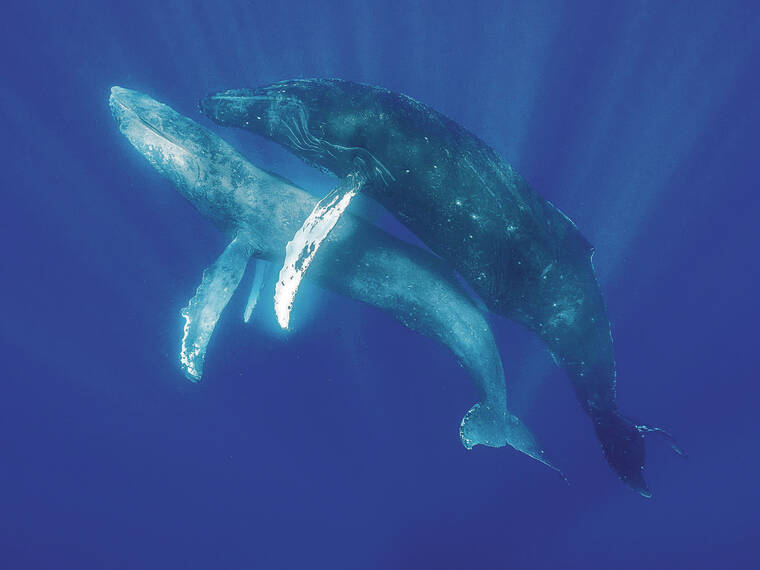Rare glimpse of humpback whales mating documented in Maui waters

COURTESY LYLE KRANNICHFELD AND BRANDI ROMANO
Photographers Lyle Krannichfeld and Brandi Romano in January 2022 captured a sexual encounter between two male whales about a mile west of Molokini Crater.
Despite decades of observations, data and research, marine animal scientists have rarely gotten a glimpse of humpback whales in the actual act of mating.
The intricacies of courtship and the act of copulation itself among the whales has long remained a mystery — with a recent breakthrough in the waters off Maui.
A team of professional Maui-based photographers documented the first-ever instance of humpback whales engaged in sexual behavior, according to the Pacific Whale Foundation.
“Obviously we see calves every year,” said Stephanie Stack, the foundation’s chief biologist and researcher. “But there have been no prior reports, at least not in scientific literature that we’re aware of, where anyone has reported seeing this happen, let alone captured footage of it.”
Photographers Lyle Krannichfeld and Brandi Romano in January 2022 just happened to be in the right place at the right time, according to Stack.
They were out on a recreational boat on the ocean, about a mile west of Molokini Crater during whale season, when two humpback whales slowly approached and began swimming around in circles.
Don't miss out on what's happening!
Stay in touch with breaking news, as it happens, conveniently in your email inbox. It's FREE!
They leaned over and held their cameras off the side of the boat in hopes of capturing footage as the whales swam about 3 to 5 meters below the surface of the water.
Upon reviewing the footage at the end of the day, they realized what they had captured and contacted the Pacific Whale Foundation.
What they stumbled upon was an encounter between two male whales, according to scientists, and not between a male and a female.
The findings of “an observation of sexual behavior between two male humpback whales” were recently published Opens in a new tab in “Marine Mammal Science.”
“This discovery challenges our preconceived notions about humpback whale behavior,” said Stack, the article’s lead author. “While we have long recognized the complex social structures of these incredible creatures, witnessing the copulation of two male whales for the first time is a unique and remarkable event.”
Upon analyzing the photos, the foundation was able to identify one of the whales from its database of tail flukes.
The encounter appeared to have occurred between a healthier, older male whale first spotted on Maui in 1993, based on the foundation’s database, and another adult male whale about 13 years old.
The younger male appears to have been injured, with a broken jaw, and was emaciated.
Stack said there are several theories for what may have been occurring between the two whales.
One possibility is that it was a case of mistaken identity, she said, in which the whale did not realize it was mating with another male.
“Hawaii is a breeding ground,” she said. “We know they come here to mate with as many whales as possible. They don’t mate for life. Humpback whales will mate with numerous mates when they get here. It’s possible it just got a little confused.”
Another possibility is that the older male was exhibiting aggressive behavior. In competition pods, whales have been observed to exhibit these behaviors to establish the position closest to the female to mate with her.
Yet another theory is that it could have been a form of social interaction between the two whales, she said, based on other animal research that has found sexual interactions can improve social bonds.
The younger whale that was in poor health has not since been spotted again, so researchers do not know its outcome.
“We’re not exactly sure why it happened,” said Stack. “In the future, if we see this more, we can collect more observations and data points, and then we’ll be able to untangle the observation a little better.”
Each year, thousands of humpback whales travel over 3,000 miles from Alaskan waters to the warmer oceans of Hawaii to breed, give birth and nurse their young.
Hawaii’s humpback whale-watching season runs from about November to April and typically peaks between January and March, although some whales can arrive earlier and linger longer.
The Hawaiian Islands Humpback Whale National Marine Sanctuary has been established to protect humpback whales and their habitat in and around Maui County waters.
The whales face a number of threats, including vessel strikes — which have already occurred in sanctuary waters this season, injuring calves — as well as entanglements with fishing lines and nets, and habitat degradation.
A few researchers have published observations about the underwater behaviors of humpback whales in breeding grounds, the article said, but they are generally not studied as much as surface behavior.
This glimpse, however, still leaves many questions about the sexual behavior of humpback whales unanswered.
“The main takeaway is we know a little more than we knew previously, but there’s still quite a lot to understand about the sexual behavior of humpback whales,” Stack said. “It still remains to be seen what mating between a male and a female looks like. It still eludes us to this day.”
—
Protecting humpback whales
>> Slow down. Officials remind boaters to slow down Opens in a new tab in sanctuary waters and post a lookout during whale season. In waters of 600 feet or less, boaters are asked to maintain a speed of 15 knots or less, and within 400 yards of a whale, 6 knots or less.
>> Federal regulations prohibit approaching within 100 yards of humpback whales when on or in the water, 1,000 feet when operating an aircraft.
>> Report an injured or entangled marine mammal to the NOAA Marine Mammal Hotline at 888-256-9840.



